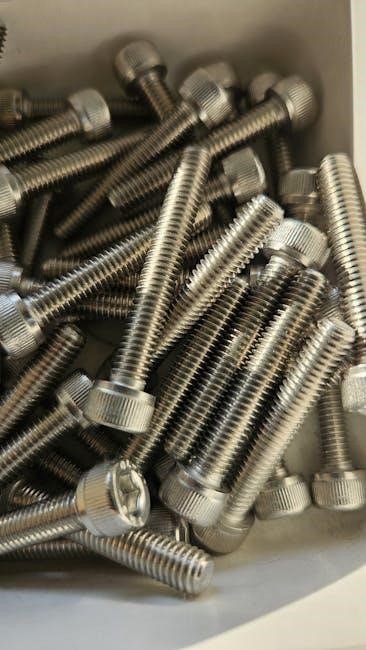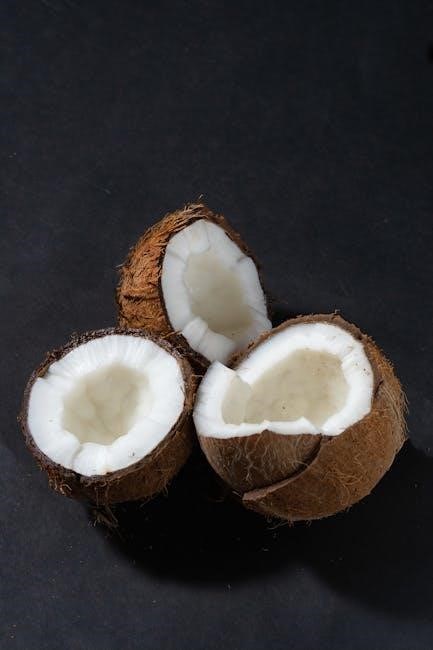Proper lug nut torque ensures safety and performance. This guide provides essential torque specifications‚ tools‚ and methods for secure wheel installation‚ suitable for both DIYers and professionals.
Understanding Torque and Its Importance
Torque‚ measured in foot-pounds (ft/lbs)‚ is the rotational force applied to lug nuts to secure wheels. Proper torque ensures wheels are tightly fastened‚ preventing loosening while driving. Over-tightening can damage studs or wheels‚ while under-tightening risks wheel loss. Typical lug nut torque ranges from 65-140 ft/lbs‚ depending on wheel material and vehicle type. Steel wheels often require higher torque (80-120 ft/lbs)‚ while aluminum wheels may need less (70-100 ft/lbs). Correct torque ensures even stress distribution‚ avoiding brake rotor warping or wheel damage. Always consult manufacturer specs for precise values‚ as incorrect torque can compromise safety and performance. Accurate torque application is critical for reliability and durability.
Factors Influencing Lug Nut Torque Specifications
Torque specs vary based on vehicle type‚ weight‚ wheel material‚ size‚ and lug nut type. Steel wheels require higher torque than aluminum‚ while larger wheels may need more force.
Vehicle Type and Weight
Vehicle type and weight significantly impact lug nut torque. Heavier vehicles‚ like trucks and RVs‚ require higher torque for stability‚ while lighter cars need less to prevent damage. Proper torque ensures safety and performance‚ avoiding wheel stud breakage or loosening. Always consult manufacturer specs for accurate values‚ as under or over-tightening can lead to safety risks. Using a torque wrench is essential for precise application‚ ensuring wheels are securely fastened without exceeding material limits. This balance is crucial for optimal vehicle handling and durability‚ making it a key factor in torque specifications.
Wheel Material and Size
Wheel material and size play a crucial role in determining torque specifications. Steel wheels typically require higher torque‚ often between 90-120 ft-lbs‚ due to their durability. Aluminum wheels‚ being lighter‚ usually need less torque‚ around 80-100 ft-lbs‚ to prevent damage. Larger wheels‚ such as 17.5-inch steel rims‚ may require up to 190-210 ft-lbs‚ while smaller sizes need less. Material differences affect thread strength‚ so torque must be adjusted accordingly. Proper torque ensures a secure fit without risking damage to studs or wheels. Always refer to manufacturer guidelines for specific values‚ as incorrect torque can lead to safety hazards or costly repairs.
Lug Nut Type and Thread Size
Lug nut type and thread size significantly influence torque specifications. Coned lug nuts typically require 90-120 ft-lbs for 1/2-inch threads‚ while 9/16-inch coned nuts need 120-140 ft-lbs. Flanged nuts‚ which don’t rotate‚ often require higher torque‚ ranging from 275-325 ft-lbs. Thread size and nut design affect the distribution of force‚ ensuring proper wheel security. Using the correct torque for specific lug nut types prevents over-tightening‚ which can damage studs or wheels. Always match torque values to the lug nut type and thread size specified by the manufacturer to maintain safety and performance. Incorrect torque can lead to loose wheels or damage‚ emphasizing the importance of accurate specifications.

Lug Nut Torque Specification Chart by Vehicle Type
Torque specifications vary by vehicle type: passenger cars (65-85 ft-lbs)‚ light trucks/SUVs (80-110 ft-lbs)‚ heavy-duty trucks/RVs (120-150 ft-lbs)‚ and motorcycles (30-60 ft-lbs). Always follow manufacturer guidelines for accuracy.
Passenger Cars
Passenger cars typically require lug nut torque between 65-85 ft-lbs‚ depending on wheel size and material. Steel wheels usually specify 80-100 ft-lbs‚ while aluminum wheels may require slightly less‚ around 83 ft-lbs. Over-torquing can damage studs‚ so precision is key. For most sedans and compact vehicles‚ 70-75 ft-lbs is common. Always refer to the manufacturer’s specifications‚ as variations exist. Re-torquing after 50-100 miles is recommended‚ especially for new installations. Proper torque ensures even stress distribution‚ preventing wheel damage and ensuring safety. Using a torque wrench is essential for accuracy. Avoid guessing to maintain vehicle integrity and performance.
Light Trucks and SUVs
Light trucks and SUVs generally require higher torque values than passenger cars‚ typically ranging from 90-140 ft-lbs. For most models‚ 100-120 ft-lbs is standard‚ but larger vehicles or those with heavy-duty wheels may need up to 140 ft-lbs. Steel wheels usually require higher torque than aluminum ones. It’s crucial to follow the manufacturer’s specifications‚ as over-torquing can damage studs or wheels. Re-torquing after 50-100 miles is recommended‚ especially for new installations. Proper torque ensures even stress distribution and prevents loosening over time. Always use a torque wrench for accuracy and refer to the vehicle’s manual for specific guidelines to maintain safety and performance.
Heavy-Duty Trucks and RVs
Heavy-duty trucks and RVs require significantly higher torque values due to their larger size and weight. Typically‚ lug nuts on these vehicles are torqued between 190-210 ft-lbs‚ depending on wheel size and material. For example‚ 5/8″ coned nuts on 17.5″ single steel wheels often require 190-210 ft-lbs. It’s critical to use a torque wrench and follow the manufacturer’s specifications‚ as over-torquing can damage studs or wheels. Re-torquing after 50-100 miles is essential‚ especially for new installations. Proper torque ensures even stress distribution and prevents loosening over time. Always refer to the vehicle’s manual for specific guidelines to maintain safety and performance.
Motorcycles
Motorcycle lug nuts typically require lower torque values compared to cars‚ usually ranging from 30-40 ft-lbs‚ depending on the make and model. This is due to their lighter weight and smaller wheel sizes. However‚ some high-performance or heavy-duty motorcycles may require slightly higher torque‚ up to 50 ft-lbs. It’s crucial to consult the owner’s manual for precise specifications‚ as over-torquing can damage the wheel studs or brake rotor. Proper torque ensures even pressure distribution and prevents wheel loosening while riding. Always use a torque wrench for accuracy and safety. Incorrect torque can lead to dangerous situations on the road‚ so attention to detail is essential.

Step-by-Step Guide to Properly Torquing Lug Nuts
Gather tools and specs‚ tighten in a star pattern‚ and apply the correct torque value for your vehicle to ensure safety and even pressure distribution.
Gathering Tools and Information
To start‚ collect a torque wrench‚ lug nut socket set‚ and your vehicle’s torque specification chart. Ensure the socket matches the lug nut size (e.g.‚ 17mm or 19mm). Check your owner’s manual or manufacturer’s website for precise torque values‚ as they vary by vehicle type and wheel material. For example‚ steel wheels typically require higher torque (around 90-120 ft-lbs) compared to aluminum wheels (80-100 ft-lbs). Also‚ gather a car jack and wheel chocks for safety. If specs are unclear‚ consult a repair manual or trusted online resources. Proper preparation ensures accuracy and safety during the torquing process.
Tightening in a Star Pattern
Tightening lug nuts in a star pattern ensures even pressure distribution. Start with one lug nut‚ then move diagonally to the next‚ continuing around the wheel. This method prevents wheel warping and brake rotor damage. For example‚ on a 4-lug wheel‚ tighten in a 1‚ 3‚ 2‚ 4 sequence. For 5-lug wheels‚ use 1‚ 3‚ 5‚ 2‚ 4; Avoid tightening adjacent nuts sequentially‚ as this can cause uneven stress. Apply the same pattern when loosening nuts. This balanced approach ensures the wheel is securely fastened without risking damage to the braking system or wheel components.
Applying the Correct Torque Value
Applying the correct torque value is crucial for wheel safety and performance. Use a torque wrench to ensure accuracy‚ starting with the recommended specification for your vehicle. Passenger cars typically range from 65-100 ft-lbs‚ while trucks and SUVs may require 100-140 ft-lbs. Always refer to your owner’s manual for precise values. Over-torquing can damage studs or wheels‚ while under-torquing risks loose nuts. Tighten in a star pattern to distribute force evenly. For new wheels or studs‚ re-torque after 50-100 miles. Double-check torque values for steel vs. aluminum wheels‚ as they differ. Proper torque ensures a secure and balanced wheel installation‚ preventing potential hazards on the road.

Common Mistakes to Avoid When Torquing Lug Nuts
One of the most common mistakes is over-torquing‚ which can damage studs or wheels; Under-torquing is equally dangerous‚ as it risks loose nuts while driving. Many people forget to tighten in a star pattern‚ leading to uneven pressure. Others skip re-torquing after the initial 50-100 miles‚ especially with new wheels or studs. Using the wrong torque value for steel vs. aluminum wheels is another error. Some rely on impact guns without finishing with a torque wrench‚ while others ignore the manufacturer’s specifications entirely. These oversights can compromise safety and performance‚ making it essential to follow proper procedures and double-check torque values.
Essential Tools for Torquing Lug Nuts
A torque wrench ensures precise torque application. An impact gun speeds initial tightening‚ while a lug nut socket set provides the necessary fit for various lug nut types.
Torque Wrench
A torque wrench is a critical tool for applying precise torque to lug nuts. It ensures the correct force is applied‚ preventing damage to wheels or brake components. Available in click‚ electronic‚ or beam styles‚ torque wrenches offer accuracy and reliability. Always calibrate your torque wrench regularly‚ as an uncalibrated tool can lead to over- or under-torquing. When using a torque wrench‚ start by tightening lug nuts in a star pattern to ensure even pressure distribution. For most vehicles‚ torque wrenches are set between 65-100 ft-lbs‚ depending on wheel material and size. Proper use of a torque wrench guarantees safety and optimal wheel performance.
Impact Gun
An impact gun is a powerful tool often used for loosening or tightening lug nuts quickly. It is commonly used in professional settings due to its efficiency. However‚ while impact guns are effective for initial loosening or tightening‚ they are not precise for final torque adjustments. Always follow the manufacturer’s torque specifications to avoid over-torquing‚ which can damage studs or wheels. For most vehicles‚ impact guns are set between 90-110 ft-lbs for passenger cars and up to 500 ft-lbs for heavy-duty trucks. After using an impact gun‚ it is essential to finish with a torque wrench for accuracy. Proper use ensures safety and prevents potential damage.
Lug Nut Socket Set
A lug nut socket set is crucial for securely fitting various lug nut sizes. It includes sockets in different diameters and depths to accommodate both standard and oversized lug nuts. The set ensures a proper fit‚ preventing rounding of the nuts. Typically‚ sizes range from 13/16″ to 1-1/16″ for most vehicles. Using the correct socket size is vital to avoid damage. Many sets are chrome-plated for durability and resistance to corrosion. A quality socket set is an essential tool for any DIYer or mechanic‚ ensuring efficient and safe lug nut tightening. Always match the socket to the lug nut size specified in your vehicle’s torque guide for optimal results and to prevent potential damage.

Importance of Re-Torquing After Installation
Re-torquing lug nuts after installation is critical for ensuring long-term safety and performance. After driving the first 50 to 100 miles‚ wheels and studs settle‚ which can cause slight loosening. Re-torquing ensures even stress distribution and prevents potential damage. This step is especially important for new wheels or replaced studs‚ as initial torque may not be evenly distributed. Proper re-torquing helps avoid loose wheels‚ which can lead to dangerous situations on the road. Always refer to your vehicle’s manufacturer specifications for the correct re-torque values. This simple step can prevent costly repairs and ensure your safety while driving.

Checking Lug Nut Torque During Routine Maintenance
Regularly checking lug nut torque is essential for maintaining wheel security and preventing potential hazards. Over time‚ lug nuts can loosen due to vibration‚ temperature changes‚ or driving conditions. Checking torque during routine maintenance ensures that all nuts remain within the manufacturer’s specified range. Use a torque wrench to verify the torque values‚ especially after new wheel installations or tire rotations. Properly tightened lug nuts prevent wheel damage‚ brake issues‚ and safety risks. Make this check part of your regular maintenance schedule to ensure optimal vehicle performance and safety on the road. Consistency is key to avoiding costly repairs and ensuring reliability.
Consequences of Over-Torquing Lug Nuts
Over-torquing lug nuts can lead to serious damage‚ including stripped threads‚ rounded lug nuts‚ and broken wheel studs. Excessive torque may also warp brake rotors or damage wheel bearings‚ causing premature wear. In extreme cases‚ over-torquing can result in wheel loss while driving‚ posing significant safety risks. Additionally‚ it may void warranty coverage for wheels or braking systems. Repairing such damage can be costly and time-consuming. Always adhere to manufacturer-recommended torque specifications to avoid these consequences and ensure safe‚ reliable vehicle operation. Proper torque application is critical for maintaining both performance and safety on the road.

Consequences of Under-Torquing Lug Nuts
Under-torquing lug nuts can lead to loose wheels‚ which may result in a wheel coming off while driving‚ posing severe safety risks. Loose lug nuts can also cause uneven brake rotor wear‚ reducing braking efficiency. Additionally‚ under-torquing may lead to excessive stress on wheel studs‚ potentially causing them to break. This can result in costly repairs‚ including replacing studs‚ wheels‚ or even brake components. Furthermore‚ loose lug nuts can damage wheel bearings‚ leading to premature wear and failure. Always ensure lug nuts are torqued to the manufacturer’s specifications to prevent these hazards and maintain vehicle safety and performance on the road.
Steel vs. Aluminum Wheels: Torque Differences
Steel and aluminum wheels require different torque specifications due to material strength and durability. Steel wheels typically need higher torque‚ around 90-120 ft-lbs‚ to ensure a secure fit. Aluminum wheels‚ being lighter and softer‚ usually require 80-100 ft-lbs to prevent damage. Over-torquing aluminum wheels can strip threads or damage studs‚ while under-torquing may lead to loose wheels. Always consult the manufacturer’s guide for precise values‚ as variations exist based on wheel size and type. Proper torque ensures safety‚ prevents wheel damage‚ and maintains optimal vehicle performance. Using the correct torque for your wheel material is crucial to avoid costly repairs and potential safety hazards on the road.
DIY vs. Professional Torque Services
When it comes to torquing lug nuts‚ the choice between DIY and professional services depends on your expertise and tools. DIY can save money and time for those with a torque wrench and proper knowledge. However‚ professionals ensure accuracy and safety‚ especially for complex or high-performance vehicles. DIY requires careful adherence to torque specs and patterns to avoid errors. Professionals use specialized tools and have experience handling various wheel types and materials. For most drivers‚ DIY is sufficient if done correctly‚ but for peace of mind‚ professional services are recommended. Always prioritize safety and accuracy to prevent wheel damage or loosening while driving.
Proper lug nut torque is essential for safety and performance. Ensuring wheels are securely fastened prevents loosening and potential damage. Factors like vehicle type‚ wheel material‚ and lug nut design influence torque specs. Over- or under-torquing can lead to costly repairs; Always follow manufacturer guidelines and consider professional services for complex cases. Regular maintenance checks are crucial to maintain safety and durability. By adhering to torque recommendations‚ drivers can enjoy a secure and reliable driving experience. Remember‚ accurate torque application is a critical step in vehicle maintenance that should never be overlooked.

Resources for Further Reading
Consult manufacturer recommendations‚ online torque charts‚ and forums like ft86club for detailed specs. Tools like AllData and torque guides provide reliable information for specific vehicles and setups.
Manufacturer Recommendations
Always refer to your vehicle’s owner’s manual or manufacturer’s website for precise lug nut torque specifications. These guidelines are tailored to your specific vehicle’s make‚ model‚ and year‚ ensuring safety and performance. Many manufacturers provide detailed torque charts‚ like the one shared by ft86club‚ which lists values for various components. Tools like AllData and Prodemand also offer accurate specs. Remember‚ torque values vary by wheel type‚ material‚ and size. For example‚ steel wheels might require 100 ft-lbs‚ while aluminum wheels could need 83 ft-lbs. Never guess; use the recommended torque to avoid damage or safety risks. Consult these resources regularly for updates and specific instructions.
Online Torque Charts and Guides
Online torque charts and guides are invaluable resources for determining accurate lug nut torque specifications. Websites like Lug Nut Torque Chart 2025 and tools such as AllData‚ Prodemand‚ and Identifix provide detailed‚ up-to-date information. These resources often include charts tailored to specific vehicle makes‚ models‚ and wheel types. For instance‚ they may list torque values for steel vs. aluminum wheels or differentiate between passenger cars and heavy-duty trucks. Online guides also offer step-by-step instructions and safety tips to avoid common mistakes. Consulting these resources ensures you apply the correct torque‚ preventing damage to wheels or brake components. Always cross-reference multiple sources for accuracy and safety.

